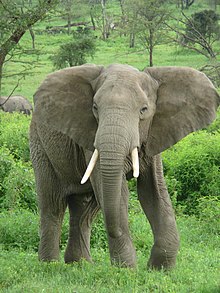
Back Savanne-olifant Afrikaans Loxodonta africana AN فيل الأدغال الإفريقي Arabic فيل الادغال الافريقى ARZ Африкаялъул пил AV Fuzol (Loxodonta africana) AVK Afrika savanna fili Azerbaijani Kunjara savana Afrika BAN Саваннавы слон Byelorussian Саванавы афрыканскі слон BE-X-OLD
| African bush elephant | |
|---|---|

| |
| Scientific classification | |
| Kingdom: | |
| Phylum: | |
| Class: | |
| Order: | |
| Family: | |
| Genus: | |
| Binomial name | |
| Loxodonta africana (Blumenbach, 1797)
| |

| |
| Range of the African bush elephant Resident Possibly resident Possibly extinct Resident and reintroduced
| |
The African bush elephant (Loxodonta africana) is the larger of the two species of African elephant.[2] It is the largest living terrestrial animal, with fully grown males reaching an average shoulder height of 3.04–3.36 metres (10.0–11.0 ft) and a body mass of 5.2–6.9 tonnes (11,000–15,000 lb); the largest recorded specimen had a shoulder height of 3.96 metres (13.0 ft) and an estimated body mass of 10.4 tonnes (23,000 lb). The African bush elephant is characterised by its long trunk.[3]
The population of bush elephants has drastically declined in the last thirty years. It is hunted for its ivory and meat. Protection by game wardens has been only partly successful.
This large elephant is well adapted to the grassland plains of East Africa, and it is sometimes called the African savannah elephant.
The African bush elephant occurs in Sub-Saharan Africa including Uganda, Kenya, Tanzania, Botswana, Zimbabwe, Mozambique, Namibia, South Africa, Zambia, and Angola.
It moves between a variety of habitats. These include subtropical and temperate forests, dry and seasonally flooded grasslands and woodlands, wetlands and agricultural land from sea level to mountain slopes. In Mali and Namibia, it also lives at times in desert areas.
- ↑ African Elephant Specialist Group (2004). Loxodonta africana. 2006 IUCN Red List of Threatened Species. IUCN 2006. Retrieved on 11 May 2006. Database entry includes a range map and a lengthy justification of why this species is vulnerable
- ↑ Shoshani, Jeheskel et al 2005. Mammal species of the world. 3rd ed, 2 vols, Baltimore: Johns Hopkins University Press, pp. 91. ISBN 978-0-8018-8221-0
- ↑ Larramendi A. 2016. Shoulder height, body mass and shape of proboscideans. Acta Palaeontologica Polonica 61 (3): 537–574. [1]
